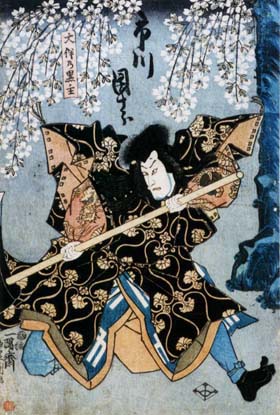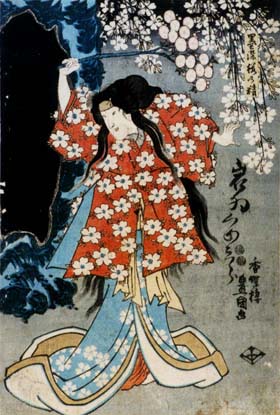| TSUMORU KOI YUKI NO SEKI NO TO |
| Play title | Tsumoru Koi Yuki no Seki no To |
| Authors | Segawa JokŰ I, Takarada Jurai (lyrics) Tobaya RichŰ I (music) Nishikawa SenzŰ II (choreography) |
| History |
The Tokiwazu-based dance-drama "Tsumoru Koi Yuki no Seki no To" was staged for the first time in the 11th lunar month of 1784 at the Kiriza, as part of the kaomise drama "JŻni Hitoe Komachi Zakura" [casting]. The lead-singer for this first performance was Tokiwazu KanedayŻ (MojitayŻ II). The full play went into oblivion but the dance-drama was independently revived more than 12 years later, at the Kiriza [casting]. From this time, this great dance-drama was regularly performed but Kabuki audiences had to wait more than 2 centuries for the first full-length revival of "JŻni Hitoe Komachi Zakura", produced by Ichikawa Ennosuke, using a new script written by Tobe Ginsaku, in April 1987 at the Meijiza [more details]. It became an important dance-drama for the Shigayama School of BuyŰ. |
| Structure |
The dance-drama "Tsumoru Koi Yuki no Seki no To" was the final act of the second part (nibanme) of the drama "JŻni Hitoe Komachi Zakura". |
| Key words |
Ebizori Kaomise BuyŰ Koto Kudoki ‘tomo Kuronushi Tokiwazu Shigayama-ryŻ Shosagoto |
| Summary |
Yoshimine Munesada is at home playing the koto. At the front gate, SekibÍ is sitting and drinking sake wine under the branches of a large cherry tree in full bloom with snow-covered mountains in the background. Ono no Komachi [mid-9th century, about 830-875] comes there to see her fiance, Munesada. At first SekibÍ refuses her entry, but Munesada discovers her presence, and they rejoice over their reunion. SekibÍ, under the influence of sake wine, speaks his mind, gossiping frankly with Munesada and Komachi. While they are taking pleasure in exchanging love stories, SekibÍ accidentally drops some Imperial seals which he has stolen and hidden for future use. He has plans to reign over the whole country. Komachi becomes aware of the seals, picks one up, and quietly puts it in her bosom. SekibÍ sees her take the seal and demands that she return it to him. When she refuses, he departs, grinding his teeth in anger and frustration. In the meantime a hawk appears bearing a letter and a sleeve stained by the blood of Munesada's brother, Yasusada. Munesada thinks that his brother must have been killed on the orders of ‘tomo no Kuronushi and his gang. The two brothers have been the targets of a conspiracy headed by Kuronushi. Just as he assumed, the letter is from a dying Yasusada. It says that, mistaking him for Munesada, Kuronushi's band has murdered him and will no longer be on the lookout for Munesada. Just then Munesada finds a mirror which is an heirloom of the Kuronushi family. Although Munesada still doesn't know that Kuronushi has disguised himself as SekibÍ, he feels danger lurking, becomes suspicious of the innocent-looking gatekeeper, and asks Komachi to go to her father for help. In the evening Munesada prays, as usual, for the repose of the late Emperor's soul. While he is holding the memorial service he includes his brother's name to be consoled. He puts his brother's blood-stained sleeve on the altar and begins praying, but suddenly realizes that the bloody item will defile the sacred place. So, he conceals it in his koto. While he is praying, SekibÍ, still under the influence of sake wine, enters. Munesada stops praying and wants to know what SekibÍ's true identity is. Though he peppers the gatekeeper with penetrating questions, SekibÍ manages to evade his close inquiry under pretense of drunkenness. After this escape SekibÍ begins drinking again. He sees stars reflected in his large sake cup and considers them to be a good omen. Hopeful and full of ambition, he decides to cut down the large cherry tree to make its branches into materials for incense. He takes a huge ax and begins sharpening it. Then he cuts Munesada's koto, which happens to be within his reach, as a test of the cutting ability of the ax. From the koto the blood-stained sleeve appears. When SekibÍ touches the sleeve the seal which he keeps miraculously flies up into the cherry tree. SekibÍ believes that some supernatural being must exist in the cherry tree. He tries to attack it with his ax, but his hands mysteriously become numb and suddenly he is unable to move under the influence of some magical power. Just then the late Yasusada's beloved courtesan, Sumizome, appears. SekibÍ looks at her with suspicion but is charmed by her beauty. She is, in fact, the spirit of the cherry tree. Once, when the spirit saw Yasusada, she was greatly attracted to him and could not bear to be separated from him. So, she transformed herself into a beautiful courtesan, and they became lovers. SekibÍ questions her closely about her life as a courtesan. At first, SekibÍ is overwhelmed by her false shows of affection, but as he questions her she gathers up the sleeve in question and begins weeping. At last she turns to him and reveals her true identity. She tells him that, as the spirit of the cherry tree, she knows who he is and what he is going to do and that it is he on whom she must take revenge for her lover's death. At last SekibÍ removes his disguise, revealing himself to be Kuronushi. The two engage in a life and death struggle. Kuronushi, with his huge ax, and Sumizome, with her magic powers. Bit by bit Kuronushi begins to succumb to Sumizome's assault. This summary has been written by Watanabe Hisao and edited by Jeff Blair [website] |
 |
 |
|
The actors Ichikawa DanjŻrŰ VIII and Iwai KumesaburŰ III playing the roles of Kuronushi and the spirit of the cherry tree in the dance-drama "Tsumoru Koi Yuki no To", which was staged in the 11th lunar month of 1846 at the Nakamuraza (print made by Utagawa Toyokuni III) |
|
| Prints & Illustrations | |
|
|
| Contact | Main | Top | Updates | Actors | Plays | Playwrights | Programs | Links | FAQ | Glossary | Chronology | Illustrations | Prints | Characters | Derivatives | Theaters | Coming soon | News |